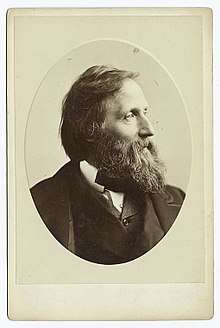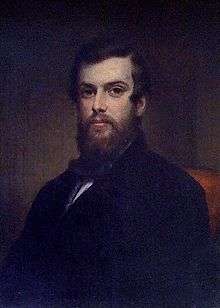Daniel Huntington (artist)

_-_Daniel_Huntington_-_overall.jpg)

.jpg)
Daniel Huntington (October 4, 1816 – April 19, 1906), American artist, was born in New York City, New York, the son of Benjamin Huntington, Jr. and Faith Trumbull Huntington; his paternal grandfather was Benjamin Huntington, delegate at the Second Continental Congress and first U.S. Representative from Connecticut. His maternal grandfather was Jedediah Huntington (4 August 1743 – 25 September 1818) of Norwich, Connecticut, who served as a General in the American Revolutionary War.
Biography
He studied at Yale with Samuel F.B. Morse, and later with Henry Inman (painter). From 1833 to 1835 he transferred to Hamilton College in Clinton, New York, where he met Charles Loring Elliott, who encouraged him to become an artist. He first exhibited his work at the National Academy of Design in 1836. Subsequently, he painted some landscapes in the tradition of the Hudson River School. Huntington made several trips to Europe, the first in 1839 traveling to England, Rome, Florence and Paris with his friend and pupil Henry Peters Gray. On his return to America in 1840, he painted his allegorical painting "Mercy's Dream", which brought him fame and confirmed his interest in inspirational subjects. He also painted portraits and began the illustration of The Pilgrim's Progress. In 1844, he went back to Rome. Returning to New York around 1846, he devoted his time chiefly to portrait-painting, although he painted many genre, religious and historical subjects.[1] From 1851 to 1859 he was in England. He was president of the National Academy of Design from 1862 to 1870, and again in 1877-1890.[1] He was also vice president of the Metropolitan Museum of Art.[2]

Works
Among his principal works are:
- "The Florentine Girl"
- "Early Christian Prisoners"
- "The Shepherd Boy of the Campagna"
- "The Roman Penitents"
- "Christiana and Her Children"
- "Queen Mary signing the Death-Warrant of Lady Jane Grey"
- "Feckenham in the Tower" (1850)
- "Chocorua" (1860)
- "Republican Court in the Time of Washington" containing sixty-four careful portraits (1861)
- "Philosophy and Christian Art" (1868)
- "Sowing the Word" (1869)
- "St Jerome, Juliet on the Balcony" (1870)
- "The Narrows, Lake George" (1871)
- "Clement VII. and Charles V. at Bologna"
- "Goldsmiths Daughter" (1884)
His principal portraits are:
- "President Lincoln" in Union League Club, New York
- "Chancellor Ferris of New York University
- General J.G. Totten (1857)at Berkshire Museum
- "Sir Charles Eastlake and the earl of Carlyle," the property of the New York Historical Society
- "President Van Buren" in the State Library at Albany
- "James Lenox" in the Lenox Library
- "Louis Agassiz" (1856-1857)
- "William Cullen Bryant" (1866)
- "Jefferson Davis" (1874)
- "John Adams Dix" (1880)
- "John Sherman" (1881)[1]
- "Alexander Ramsey" (1881)
- "Chester A. Arthur" (1885)
References
- 1 2 3

- ↑ Looking at Pictures in the Grand Salon: a guide to the artists. Smithsonian American Art Museum, Renwick Gallery.
External links
- A collection of Huntington's work as held in the Cooper-Hewitt, National Design Museum
- Historic New England. Huntington's portrait of Mary Wheelwright Codman, 1845
- The Daniel Huntington Study Portrait Photographs Collection at the New-York Historical Society
- Bedford Fine Art Gallery: Daniel Huntington